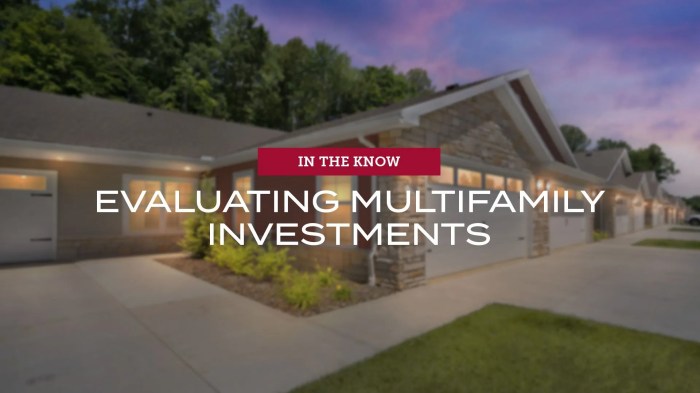How to Analyze Multifamily Investment Opportunities sets the stage for a comprehensive exploration of this lucrative real estate sector. This guide delves into the intricacies of evaluating multifamily properties, from understanding fundamental market dynamics and conducting thorough financial analyses to navigating the complexities of due diligence, operational efficiency, financing, and legal considerations. We will equip you with the knowledge and tools necessary to make informed investment decisions, ultimately maximizing your return on investment.
Through a structured approach, we’ll examine key market indicators, various financial metrics (including capitalization rates and discounted cash flow analysis), and effective property management strategies. We will also address crucial aspects such as securing financing, understanding legal and regulatory requirements, and developing sound exit strategies. By the end, you will possess a robust framework for evaluating and selecting promising multifamily investment opportunities.
Understanding Market Fundamentals
Analyzing multifamily investment opportunities requires a deep understanding of the underlying market dynamics. Property values are not static; they fluctuate based on a complex interplay of economic, demographic, and local factors. A thorough market analysis is crucial for identifying promising investment prospects and mitigating potential risks.
Factors influencing multifamily property values vary significantly across different markets. Economic conditions, such as job growth, interest rates, and inflation, play a major role. Strong employment and a healthy economy typically lead to increased demand for rental housing, driving up property values. Conversely, economic downturns can depress rental rates and property values. Demographic trends, including population growth, age distribution, and household size, also influence demand.
Areas with a growing population and a high proportion of young adults or families are likely to experience stronger rental demand. Local factors such as the quality of schools, proximity to employment centers, and the availability of amenities also significantly impact property values. For example, a multifamily property near a major university or a thriving business district will likely command higher rents and appreciate faster than a similar property in a less desirable location.
Market Analysis Process
Conducting a thorough market analysis involves a systematic approach. It begins with defining the target geographic area, considering factors like population density, income levels, and existing housing stock. Next, analyze the local economy, including job growth, unemployment rates, and average household income. This data provides insights into the potential rental demand. Further investigation should include examining the competitive landscape, identifying the types and quality of existing rental properties, and assessing vacancy rates.
Analyzing demographic data, including age distribution, household size, and population growth, provides valuable information on the future demand for rental units. Finally, consider local regulations, zoning laws, and property tax rates, as these factors can significantly influence investment returns.
Comparative Analysis of Multifamily Property Types
Multifamily properties come in various types, each with its own characteristics and investment implications. Garden apartments, typically low-rise buildings with on-site parking, are often favored for their lower construction costs and ease of management. High-rise buildings, on the other hand, offer higher density and potential for greater rental income but come with higher construction and maintenance costs. Mid-rise buildings represent a middle ground, balancing density and management complexity.
The choice of property type depends on factors like the target market, land availability, and investment budget. For instance, a high-rise building might be suitable for a dense urban area with a high demand for luxury apartments, while garden apartments might be more appropriate for suburban areas with larger land parcels.
Key Market Indicators and Their Relevance, How to analyze multifamily investment opportunities
The following table summarizes key market indicators and their relevance to multifamily investment decisions.
| Indicator | Description | Relevance to Investment | Example |
|---|---|---|---|
| Vacancy Rate | Percentage of vacant rental units | Low vacancy rates indicate high demand; high rates suggest potential oversupply. | A vacancy rate of 2% suggests strong demand, while 10% indicates a weak market. |
| Average Rent Growth | Annual increase in average rental rates | Indicates the potential for rental income growth. | Consistent 3-5% annual rent growth is considered healthy. |
| Population Growth | Annual change in population | Growing population suggests increasing demand for rental housing. | A population growth rate of 2% annually indicates a strong market. |
| Job Growth | Annual change in employment | Strong job growth indicates increased income and demand for housing. | A 4% annual job growth rate is positive for rental demand. |
Financial Analysis Techniques

Sound financial analysis is crucial for successful multifamily investment. This section will explore key techniques used to evaluate the financial viability of multifamily properties, enabling investors to make informed decisions and maximize returns. We will delve into capitalization rates, net operating income calculations, discounted cash flow analysis, and a comparison of relevant financial metrics.
Capitalization Rates (Cap Rates) in Multifamily Investment
Cap rates are a fundamental metric in real estate investment, providing a quick snapshot of a property’s potential return relative to its current market value. The cap rate represents the ratio of net operating income (NOI) to the property’s purchase price or current market value. A higher cap rate generally indicates a potentially more attractive investment, suggesting a higher return on investment for a given price.
However, it’s essential to consider the underlying factors contributing to the cap rate, such as market conditions, property condition, and lease terms. A seemingly high cap rate might reflect higher risk rather than superior potential. For example, a property with a 10% cap rate in a rapidly developing area might be more attractive than a property with a 12% cap rate in a declining neighborhood.
Investors often use cap rates to benchmark properties against similar investments in the same market.
Net Operating Income (NOI) Calculation Methods and Significance
Net operating income (NOI) is a key indicator of a property’s profitability. It represents the income generated by a property after deducting all operating expenses but before accounting for debt service (mortgage payments), taxes, and depreciation. There are two primary methods for calculating NOI: the direct capitalization method and the discounted cash flow (DCF) method. The direct capitalization method uses the property’s net operating income and a capitalization rate to estimate the value.
The DCF method, on the other hand, projects future cash flows and discounts them back to their present value.The direct method involves subtracting operating expenses from revenue. For instance, if a property generates $100,000 in annual rental income and has operating expenses of $20,000 (property taxes, insurance, maintenance, management fees etc.), the NOI is $80,000. This simplified example doesn’t account for vacancies or other potential revenue streams like laundry or parking.
A more comprehensive approach includes detailed budgeting and forecasting of all income and expenses. NOI is significant because it provides a standardized measure of profitability, allowing for comparisons between different properties.
Discounted Cash Flow (DCF) Analysis: A Step-by-Step Process
A discounted cash flow (DCF) analysis is a more sophisticated valuation method that projects future cash flows from the property over a holding period and discounts them back to their present value using a discount rate. This discount rate reflects the risk associated with the investment. A higher discount rate signifies a higher perceived risk and results in a lower present value.
A DCF analysis provides a more comprehensive picture of a property’s potential return compared to a simple cap rate analysis.Here’s a step-by-step process for performing a DCF analysis:
- Project future net operating income (NOI): Forecast the NOI for each year of the holding period, considering factors like rent increases, vacancy rates, and operating expense growth.
- Determine the terminal value: Estimate the value of the property at the end of the holding period. This is often done using a capitalization rate applied to the projected NOI in the final year.
- Select a discount rate: This rate reflects the required rate of return for the investment, considering the risk involved. It is often determined based on the weighted average cost of capital (WACC) or comparable investment opportunities.
- Discount future cash flows: Discount each year’s NOI and the terminal value back to their present value using the chosen discount rate. This is typically done using a present value formula.
- Sum the present values: The sum of the present values of the annual NOI and the terminal value represents the net present value (NPV) of the investment.
For example, consider a property with projected annual NOI of $100,000 for five years and a terminal value of $1,000,000. With a discount rate of 10%, the DCF analysis would discount each year’s NOI and the terminal value back to their present value and sum them to arrive at the NPV. A positive NPV suggests the investment is potentially profitable.
Comparison of Financial Metrics for Multifamily Property Evaluation
Several financial metrics are used to evaluate multifamily properties. These include cap rates, NOI, DCF analysis, internal rate of return (IRR), and cash-on-cash return. Each metric offers a different perspective on the investment’s profitability and risk. Cap rates provide a quick measure of potential return relative to price, while NOI focuses on the property’s operating profitability. DCF analysis provides a more comprehensive picture of long-term value, considering the time value of money.
IRR calculates the discount rate that makes the NPV of the investment equal to zero, indicating the investment’s overall profitability. Cash-on-cash return measures the annual before-tax cash flow as a percentage of the initial cash investment, useful for evaluating the immediate return on investment. The selection of the most relevant metric depends on the specific investment goals and risk tolerance of the investor.
A balanced approach, considering multiple metrics, is generally recommended for a thorough assessment.
Property Due Diligence

Thorough due diligence is crucial for mitigating risk and maximizing returns in multifamily investments. This process involves a comprehensive examination of the property’s physical condition, financial performance, and legal compliance, ensuring a clear understanding of both potential opportunities and challenges before committing to a purchase. A diligent approach can safeguard against unforeseen expenses and operational issues, leading to a more successful investment.
Identifying Potential Risks and Opportunities
Acquiring a multifamily property presents a unique blend of risks and opportunities. Potential risks include deferred maintenance, hidden structural problems, negative cash flow, and unexpected legal issues. Conversely, opportunities exist in value-add renovations, rent increases based on market conditions, and potential for strong appreciation in the property’s value. A detailed due diligence process allows investors to weigh these factors and make informed decisions.
For example, a property with deferred maintenance might present a higher initial risk but also a greater opportunity for profit through renovations and subsequent rent increases. Conversely, a property in excellent condition might offer lower risk but also a lower potential for significant value appreciation.
Inspecting a Multifamily Property
A thorough physical inspection of the property is paramount. This involves a systematic review of the building’s exterior and interior, including common areas, individual units, and building systems. The inspection should identify any signs of deterioration, damage, or needed repairs. This may involve engaging qualified professionals, such as structural engineers, to assess specific areas of concern. For instance, a visual inspection might reveal cracks in the foundation or water damage in the basement, necessitating further investigation by a structural engineer.
Similarly, an HVAC professional should inspect the heating, ventilation, and air conditioning systems for efficiency and potential malfunctions. Detailed documentation, including photographs and written reports, should be maintained throughout the inspection process.
Due Diligence Checklist for Multifamily Investments
A comprehensive checklist is essential for ensuring thorough due diligence. This checklist should encompass various aspects, including:
- Property Inspection: Exterior and interior assessment, including structural components, roofing, landscaping, and common areas.
- Unit Inspections: Review of each unit’s condition, appliances, and fixtures.
- Building Systems Assessment: HVAC, plumbing, electrical, fire safety, and security systems.
- Financial Review: Analysis of income statements, operating statements, and rent rolls.
- Legal Review: Examination of title insurance, leases, permits, and zoning regulations.
- Market Analysis: Assessment of comparable properties, rental rates, and occupancy trends.
- Environmental Assessment: Review for potential environmental hazards, such as asbestos or lead paint.
This checklist provides a framework; its specific items should be tailored to the individual property and its circumstances.
Assessing the Condition of Building Systems
Assessing the condition of building systems (HVAC, plumbing, and electrical) is critical. This often requires the expertise of qualified professionals. For HVAC systems, the assessment should include evaluating the age and efficiency of equipment, identifying potential repairs or replacements, and assessing the overall functionality of the system. Plumbing assessments should cover the condition of pipes, fixtures, water heaters, and drainage systems, noting any signs of leaks, corrosion, or potential failures.
Electrical system inspections should include checking the panel box, wiring, and outlets for safety and compliance with building codes. The cost of necessary repairs or replacements should be factored into the overall investment analysis. For example, an outdated HVAC system might require a significant investment for replacement, impacting the property’s overall profitability. Similarly, significant plumbing issues could lead to costly repairs and potential disruption to tenants.
Evaluating Operational Efficiency

Operational efficiency is paramount in maximizing the return on investment (ROI) of a multifamily property. Effective management directly impacts profitability, and a thorough understanding of operational aspects is crucial for successful investment. This section explores strategies for enhancing operational efficiency, focusing on key areas such as occupancy rates, rent collection, and property management practices.
Strategies for Improving Occupancy Rates
Maintaining high occupancy rates is critical for consistent revenue generation. Several strategies can be employed to achieve this. Marketing and advertising efforts should be tailored to the target demographic, utilizing both online and offline channels. Competitive rental rates, attractive amenities, and a well-maintained property are also key factors. Furthermore, proactive tenant retention strategies, such as offering lease renewal incentives and addressing tenant concerns promptly, can significantly reduce vacancy periods.
For example, a property might offer a discounted rent for early lease renewal or provide free upgrades to existing tenants. Efficient and responsive property management directly contributes to higher occupancy rates through quick turnaround times on repairs and effective communication with tenants.
The Importance of Rent Collection and Its Impact on Overall Profitability
Timely rent collection is the lifeblood of a multifamily investment. Delinquent rent payments directly impact cash flow and overall profitability. Implementing a robust rent collection system, including clear lease agreements, automated payment options, and a proactive approach to addressing late payments, is essential. This system might include online portals for rent payment, automated reminders, and a clear escalation process for late payments, potentially involving late fees or legal action as a last resort.
A well-defined policy regarding late fees and eviction procedures, while ethically sound, is necessary to maintain financial stability. The impact of even a small percentage of consistently delinquent rent can be substantial over time, significantly impacting profitability.
Effective Property Management Practices that Enhance ROI
Effective property management goes beyond simply collecting rent; it encompasses a comprehensive approach to maintaining and enhancing the value of the property. This includes preventative maintenance to minimize costly repairs, responsive handling of tenant requests, and a focus on building a positive tenant community. For instance, regular inspections can identify and address minor issues before they escalate into major problems.
Furthermore, creating a welcoming community through organized tenant events can improve tenant satisfaction and retention. Investing in energy-efficient upgrades, such as LED lighting or smart thermostats, can reduce operating costs and increase the property’s value. A professional property management company, or a highly skilled and experienced in-house team, can provide expertise in all these areas, leading to increased ROI.
Key Performance Indicators (KPIs) for Multifamily Property Operations
Understanding key performance indicators (KPIs) is essential for tracking operational efficiency and making data-driven decisions. Regular monitoring of these metrics provides valuable insights into the property’s performance.
- Occupancy Rate: The percentage of occupied units.
- Rent Collection Rate: The percentage of rent collected on time.
- Net Operating Income (NOI): Revenue minus operating expenses.
- Return on Investment (ROI): The profitability of the investment.
- Tenant Turnover Rate: The percentage of tenants who move out each year.
- Average Rent per Unit: The average monthly rent collected per unit.
- Operating Expenses Ratio: Operating expenses as a percentage of revenue.
- Days to Lease: The average number of days it takes to lease a vacant unit.
Financing and Capitalization

Securing appropriate financing is crucial for successful multifamily investment. The right financing strategy can significantly impact profitability, while an unsuitable one can jeopardize the entire venture. This section explores various financing options, the significance of loan terms, and the process of securing financing for a multifamily property acquisition. We will also examine the impact of different financing scenarios on investment profitability through a simplified financial model.Financing options for multifamily investments are diverse and depend on factors such as the investor’s creditworthiness, the property’s characteristics, and prevailing market conditions.
Comparison of Financing Options
Several financing avenues exist for multifamily investments. These include traditional bank loans, commercial mortgage-backed securities (CMBS) loans, private equity financing, and seller financing. Each option possesses unique features regarding interest rates, loan terms, and eligibility criteria. Bank loans typically offer competitive rates for well-qualified borrowers, but they may involve stringent underwriting requirements. CMBS loans often involve larger loan amounts but might have stricter terms.
Private equity financing provides flexibility but usually demands higher returns. Seller financing can be attractive when market conditions are challenging, offering a potentially more lenient qualification process. The optimal choice depends on the specific circumstances of the investment. A thorough comparison of these options, considering the risk tolerance and financial capacity of the investor, is essential before committing to a specific financing strategy.
Importance of Loan Terms and Interest Rates
Loan terms and interest rates are paramount in determining the overall financial viability of a multifamily investment. The interest rate directly impacts the monthly mortgage payments and the overall cost of borrowing. Lower interest rates translate to lower monthly payments, leaving more cash flow available for other expenses or returns. Loan terms, which include the loan amortization period and prepayment penalties, influence the investor’s long-term financial obligations.
A shorter amortization period leads to faster loan repayment but higher monthly payments, while a longer period results in lower monthly payments but higher overall interest costs. Prepayment penalties can restrict the investor’s flexibility to refinance or sell the property early. Therefore, careful consideration of these factors is crucial for maximizing returns and minimizing risk. For example, a 30-year fixed-rate mortgage will have lower monthly payments than a 15-year mortgage but will result in a significantly higher total interest paid over the life of the loan.
Securing Financing for Multifamily Property Acquisition
Securing financing for a multifamily property involves several key steps. First, the investor needs to prepare a comprehensive business plan outlining the investment strategy, including market analysis, financial projections, and an exit strategy. This plan serves as the foundation for attracting lenders and securing financing. Next, the investor must identify potential lenders, including banks, credit unions, and private lenders.
The selection process should consider factors such as interest rates, loan terms, and lender reputation. A strong credit score and sufficient equity are crucial for securing favorable loan terms. The investor will need to provide extensive documentation, including financial statements, property appraisals, and market analysis reports, to support the loan application. Finally, the lender will conduct a thorough due diligence process to assess the creditworthiness of the borrower and the value and risk associated with the property.
Successfully navigating this process requires meticulous preparation and a clear understanding of the lender’s requirements.
Financial Model: Impact of Different Financing Scenarios
A simplified financial model can illustrate the impact of different financing scenarios on profitability. Consider a $1 million property purchase with a potential 8% capitalization rate.
| Financing Scenario | Loan Amount | Interest Rate | Loan Term (Years) | Annual Debt Service | Net Operating Income (NOI) | Before-Tax Cash Flow | Cash-on-Cash Return |
|---|---|---|---|---|---|---|---|
| Scenario 1: 70% LTV, 5% Interest | $700,000 | 5% | 30 | $42,000 | $80,000 | $38,000 | 5.4% |
| Scenario 2: 80% LTV, 6% Interest | $800,000 | 6% | 30 | $57,600 | $80,000 | $22,400 | 2.8% |
Note: NOI is assumed to be $80,000 for both scenarios. Annual debt service is a simplified calculation and does not include property taxes or insurance. Cash-on-Cash Return is calculated as (Before-Tax Cash Flow / Equity Invested) – 100.This model demonstrates how higher loan amounts and interest rates can significantly reduce the before-tax cash flow and the cash-on-cash return. This highlights the importance of carefully evaluating various financing options to optimize profitability. This is a simplified model; a more comprehensive model would incorporate additional factors such as property taxes, insurance, and potential operating expenses.
Legal and Regulatory Considerations: How To Analyze Multifamily Investment Opportunities

Investing in multifamily properties requires a thorough understanding of the legal and regulatory landscape. Failure to comply with relevant laws and regulations can lead to significant financial losses, legal disputes, and reputational damage. This section Artikels key legal and regulatory factors to consider throughout the investment process, from acquisition to ongoing operation.
Local Zoning Laws and Building Codes
Local zoning laws dictate the permissible uses of land and buildings within a specific area. These regulations define allowed building heights, density (units per acre), setbacks (distance from property lines), parking requirements, and permissible uses (residential, commercial, mixed-use). Building codes, on the other hand, establish minimum standards for construction, safety, and accessibility. Understanding these regulations is crucial for determining the feasibility of a project, potential renovation plans, and compliance with existing structures.
For example, a zoning ordinance might restrict the number of units allowed on a given lot, impacting the potential return on investment. Similarly, outdated building codes might necessitate costly renovations to meet current safety standards. Failure to comply with zoning laws can result in fines, stop-work orders, or even demolition.
Common Legal Issues in Multifamily Acquisitions and Operations
Several legal issues frequently arise during the acquisition and operation of multifamily properties. These include title disputes (challenges to the legal ownership of the property), lease agreements (ensuring compliance with fair housing laws and tenant rights), environmental liabilities (contamination issues), and property tax assessments (appealing inaccurate assessments). For instance, a title search might reveal outstanding liens or easements that could impact the investment’s value or operational efficiency.
Similarly, failing to properly screen tenants or adhering to fair housing laws can result in costly legal battles and reputational damage. Furthermore, unforeseen environmental contamination can lead to significant remediation costs.
Environmental Due Diligence
Environmental due diligence is a critical aspect of the acquisition process. It involves investigating the property for potential environmental hazards, such as asbestos, lead-based paint, underground storage tanks, or soil contamination. This process typically includes a Phase I Environmental Site Assessment, which involves a review of historical records and a site visit to identify potential environmental concerns. If potential contamination is identified, further investigation (Phase II) may be necessary.
Failing to conduct thorough environmental due diligence can expose investors to significant liability for cleanup costs and potential legal actions. For example, the discovery of asbestos in a building could lead to costly abatement procedures before renovations can commence. Ignoring such issues could result in significant fines and legal repercussions.
Exit Strategies

A well-defined exit strategy is crucial for maximizing returns on multifamily investments. Understanding the various options available and their associated implications is vital for successful long-term investment planning. This section explores several common exit strategies, comparing their advantages and disadvantages, and examining factors influencing the optimal timing for each.
Refinancing
Refinancing involves replacing an existing mortgage with a new one, often at a lower interest rate or with a different loan structure. This strategy allows investors to access equity built up in the property, providing capital for other investments, renovations, or debt reduction. The advantages include accessing cash flow without selling the property and potentially lowering monthly payments.
However, refinancing requires meeting lender qualifications, and fees associated with the process can reduce the overall benefit. The success of this strategy hinges on prevailing interest rates and the property’s continued appreciation. For example, an investor who purchased a property five years ago with a higher interest rate might refinance at a lower rate, freeing up cash flow for improvements or other investments.
Sale
Selling the property is a straightforward exit strategy, offering immediate liquidity. The profit is realized through the sale price minus the original purchase price, accumulated expenses, and any outstanding debt. A strong market with high demand can significantly increase the return on investment. However, this strategy requires finding a buyer, incurring closing costs, and potentially facing capital gains taxes.
The timing of a sale is heavily influenced by market conditions; selling during a peak market maximizes profit, while selling during a downturn might result in a loss. For instance, an investor might sell a property in a rapidly appreciating market to capitalize on high demand and achieve a substantial return.
1031 Exchange
A 1031 exchange allows investors to defer capital gains taxes by reinvesting the proceeds from the sale of one investment property into another “like-kind” property. This strategy is particularly advantageous for long-term investors looking to upgrade their holdings or diversify their portfolio without incurring immediate tax liabilities. The complexities of a 1031 exchange, however, require careful planning and adherence to strict IRS regulations.
It’s essential to find a suitable replacement property within the designated timeframe and to work with qualified professionals to ensure compliance. For example, an investor might sell an older apartment building and exchange the proceeds for a newer, more energy-efficient complex in a growing market, deferring taxes while improving their investment portfolio.
Factors Influencing Exit Strategy Timing
Several factors influence the optimal timing of an exit strategy. These include market conditions (supply and demand, interest rates, economic outlook), property performance (occupancy rates, rent growth, operating expenses), and investor goals (liquidity needs, risk tolerance, tax implications). A thorough understanding of these factors is crucial for making informed decisions.
Potential Returns for Each Exit Strategy
The actual returns vary significantly depending on individual circumstances and market conditions. The following table provides a simplified illustration of potential returns, assuming a $1 million investment property with a 5% annual appreciation rate. These are illustrative examples and should not be considered financial advice.
| Exit Strategy | Holding Period (Years) | Sale Price (Estimate) | Approximate Return (Before Taxes & Expenses) |
|---|---|---|---|
| Sale | 5 | $1,276,282 | 27.6% |
| Sale | 10 | $1,628,895 | 62.9% |
| Refinancing (Partial Equity Withdrawal) | 5 | N/A | Variable (dependent on loan terms and equity withdrawn) |
| 1031 Exchange | 5 | N/A | Deferred capital gains tax liability, potential for future appreciation |
Concluding Remarks

Mastering the art of analyzing multifamily investment opportunities requires a multifaceted approach that blends market knowledge, financial acumen, and due diligence. This guide has provided a roadmap, equipping you with the tools to navigate the complexities of this rewarding yet demanding investment landscape. By understanding market fundamentals, employing robust financial analysis techniques, and conducting thorough due diligence, you can confidently identify and capitalize on lucrative multifamily investment prospects.
Remember that continuous learning and adaptation are key to long-term success in this dynamic market.